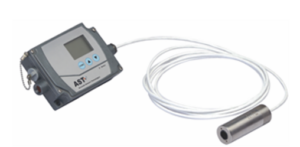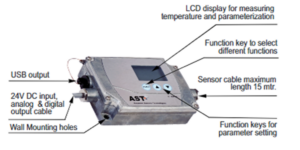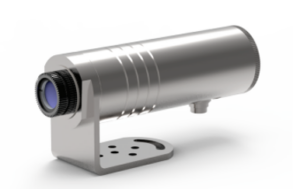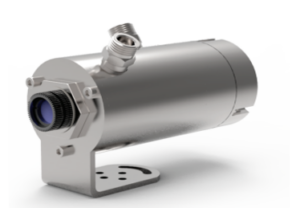1300 737 976
Call us
Live Chat
Call us
How to Select the Correct Infrared Thermometer.

Once fitted in place, the fixed infrared sensor will provide continuous temperature measurement of the target from a distance. No contact is needed to transfer heat energy. It’s all done optically. The fixed infrared device, unlike a portable unit, doesn’t usually need an integral temperature display as no-one will be there to view it. The infrared sensor will transmit measured values using instrumentation standard signals such as 4-20mA updating values as fast as 100mSec. These signals will then be used by automatic control systems.
Portable infrared for is spot-checks, fixed infrared is for continuous measurement and control.
We won’t talk about how infrared temperature works here. You can find that easily online. We do need to understand that some measurement applications provide extreme technical challenges, but most do not.
Starting with a basic featured, economic model that has some functional flexibility. An example of a well featured economic model is the AST EL50 from Pyrosales Australia.

Basic models will satisfy around 80% of total fixed infrared temperature measurement applications. We would consider a higher specification model if one or more of the following conditions were not satisfied:
Infrared energy from the target is focused on an internal detector much the same way a camera focuses light on to a detector to take a photograph. The performance of the lens array will determine the optical properties of the temperature sensor. If you have a wide-angle lens, you will see a lot of the target from a short distance. If you have a telephoto lens, you will measure the same target size from a considerable distance away compared to the wide-angle lens.
In fixed infrared temperature sensor terminology, we don’t use focal length and terms “wide-angle” or “telephoto”, we use a simple descriptor ‘Distance to Size’ ratio or D:S of “Field of View” (FOV) expressed in the same ratio. At distance ‘D’, the size of the measured area spot will be ‘S’. For example, a 10:1 Distance to Size specification would mean that we are measuring an area 1m diameter from a distance of 10m. The closer we are to the target, the smaller the measurement spot size becomes using the ratio 10:1.
A simple concept but a very important determinant of which infrared sensor model is best for the application. If we are unable to mount the sensor close to the target and the measurement area on the target is quite small, we are going to need higher performing optics to measure a small target from a greater distance.
Basic infrared temperature sensors measure to 500℃. Some may go to 800℃. Getting a little technical, basic model infrared sensors, will filter the infrared energy received to be within 8-14um (microns). In this spectrum, there is more than enough energy to determine temperature.
If we know that our measurement target is higher than the range of basic sensors, we will need to choose a model specifically designed for high temperatures.


We now need to consider infrared sensors designed for high temperature applications that feature options for air or water cooling-jackets. You guessed it, these specialised options will be offered on models for high temperature measurement applications. There are limited cooling options available in basic models and sometimes it’s just a dust suppressor for the lens called an “air purge” collar.
The subject here is not really what it first appears. In practical application, we always want to ensure that what we are measuring (the target) always completely fills the field of view. If the sensor is looking at 80% target and 20% something else, we will get readings from both objects simultaneously. The reading will assume the average energy from both sources and be inaccurate, so it is vital that the sensor is aimed wholly at the target. If we need to adjust, we can move further or closer to the target or choose a different lens option with ideal D:S ratio.
There are some applications where it is impossible to position a sensor to focus wholly on the target. The surface of molten steel or iron with slag covering the 90% of the surface is a classic example. The true temperature can only be measured by aiming at the cracks where the glowing metal appears.
There are specialised high temperature infrared sensors that are designed to overcome such challenges by using two measurements simultaneously at different wavelengths. They are referred to as dual wavelength infrared sensors or “2-Colour” sensors. The sensors use a different algorithm to determine temperature and instead of measuring the absolute energy emitted to determine temperature, they in-fact measure the changes in the ratio of the two readings which will change according to temperature. The penalty though is that the lower limit of measurement is around 450℃.
As dual wavelength does not measure absolute emitted energy to determine temperature and needs only to measure the ratio between the two values, the dual wavelength solution is perfect for higher temperature applications where the target can be obscured by smoke, steam, or grime building up on protective windows covering the lens. The dual wavelength sensor models will generally permit a reduction of around 90% of absolute energy and still be able to measure the ratios (and temperature) perfectly.
Although the dual wavelength models will physically appear the same size, there is considerably more electronics and technology packed inside so expect to pay a lot more for dual wavelength sensors than single wavelength sensors. If it is a difficult application and only a dual wavelength sensor will do the job, don’t make the mistake of believing a single wavelength sensor will work. There is a reason dual wavelength technology was developed!
There is quite a lot to know when working with infrared applications, so it pays to discuss your application with an experienced provider of infrared sensor solutions. If the application is complex and conversation over a phone is a little impractical, a site visit will be invaluable.
Pyrosales is a leading provider of temperature solutions with extensive experience on low, medium, and particularly high temperature sensor design and manufacturing. For applications requiring non-contact measurement, Pyrosales represents Accurate Sensor Technologies who design and manufacture an extensive range of infrared temperature measurement solutions, process thermal imaging and video graphic imaging solutions for industrial applications.
FOR MORE INFORMATION CLICK HERE
Copyright © 2022 Created by Pepper Digital
Disclaimer – Images for illustrative purposes only and may not be representative of the actual resolution of the camera shown.